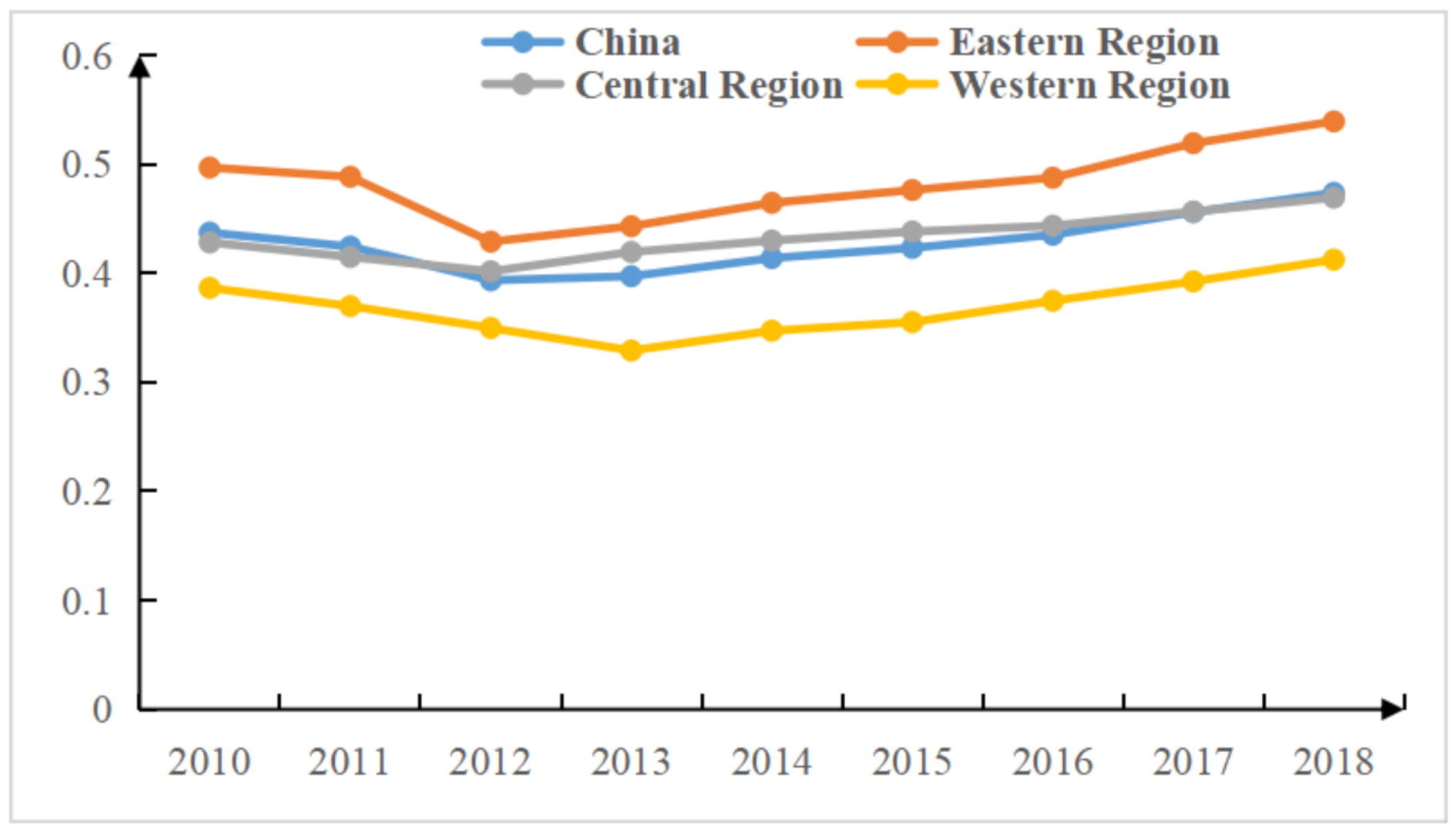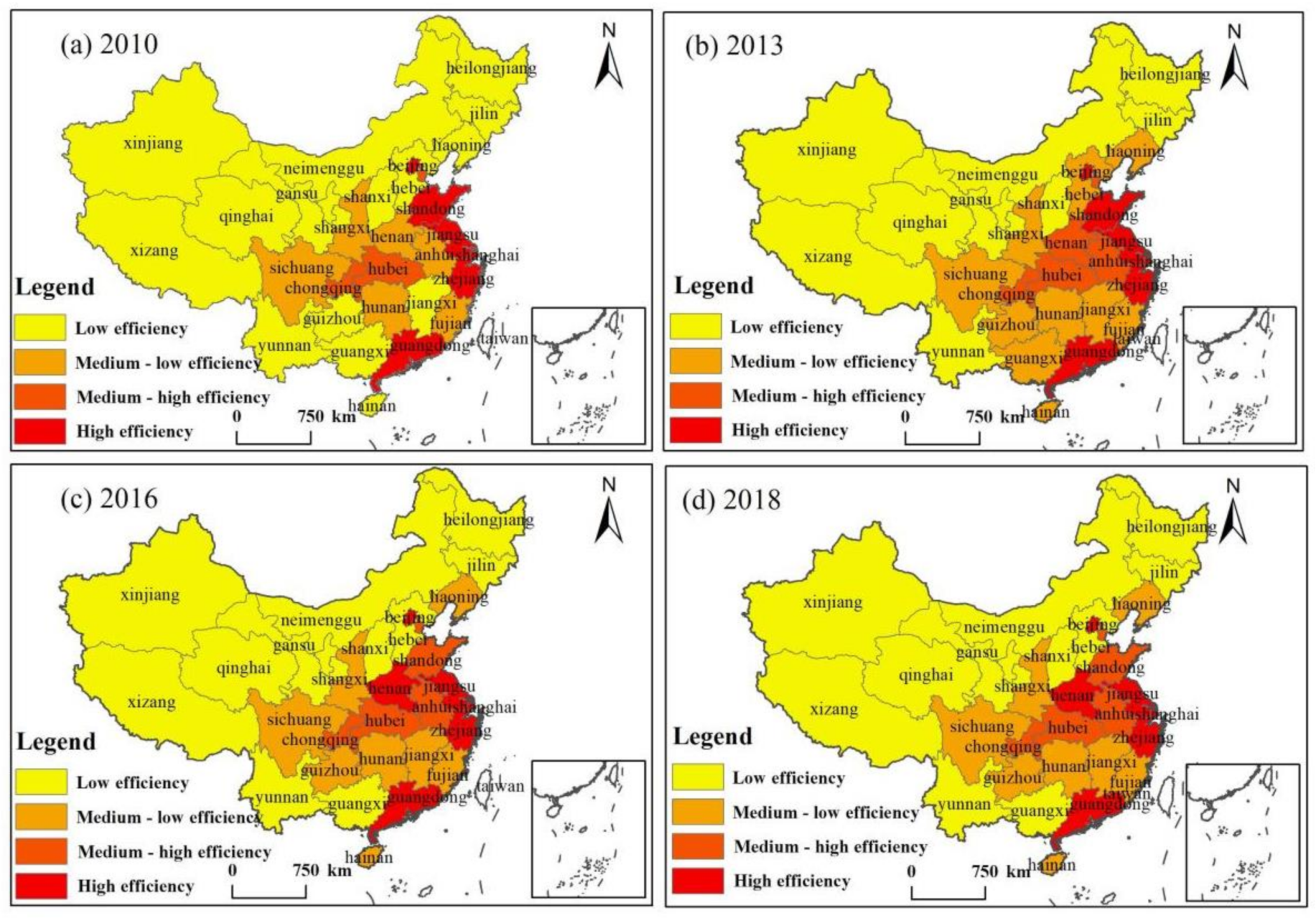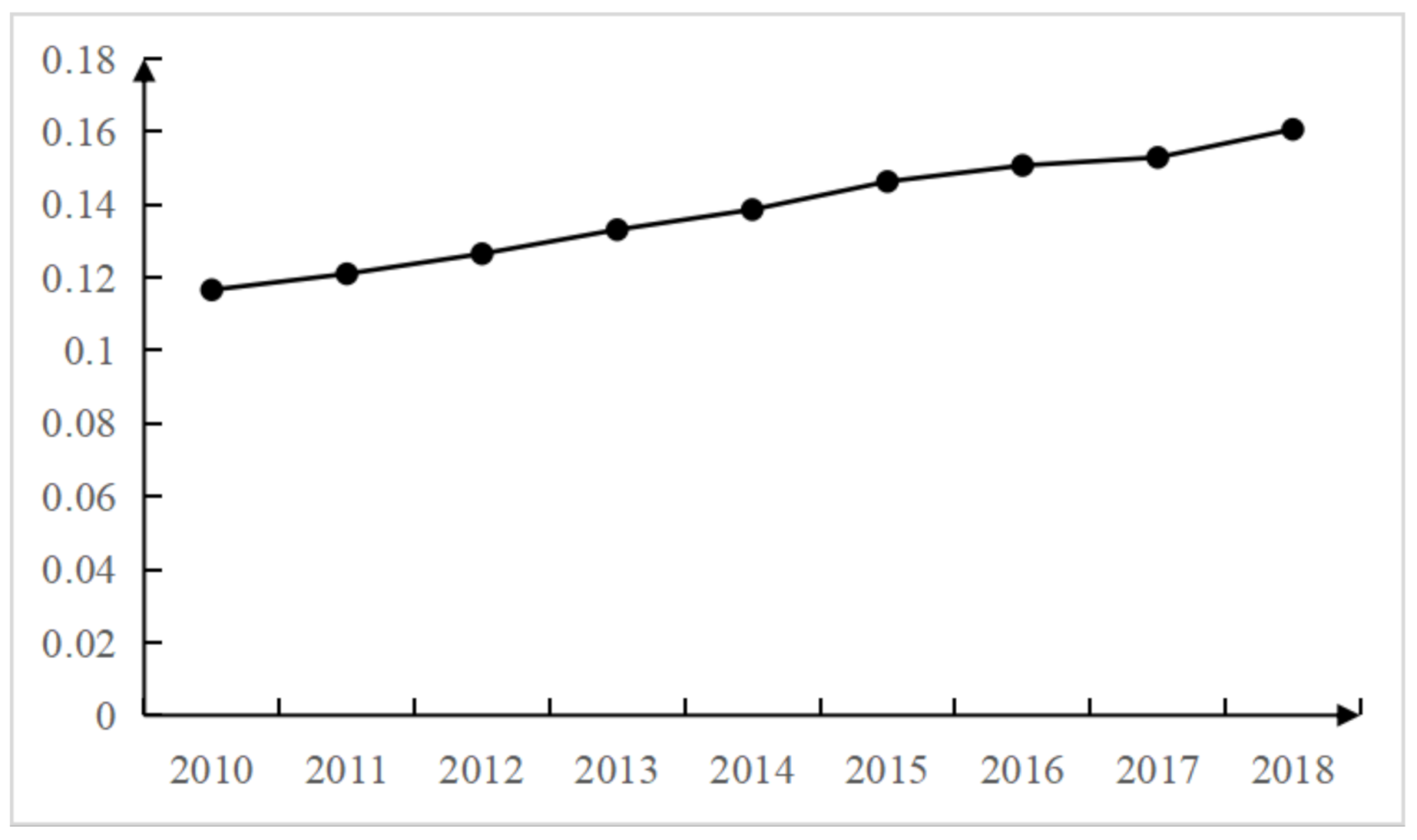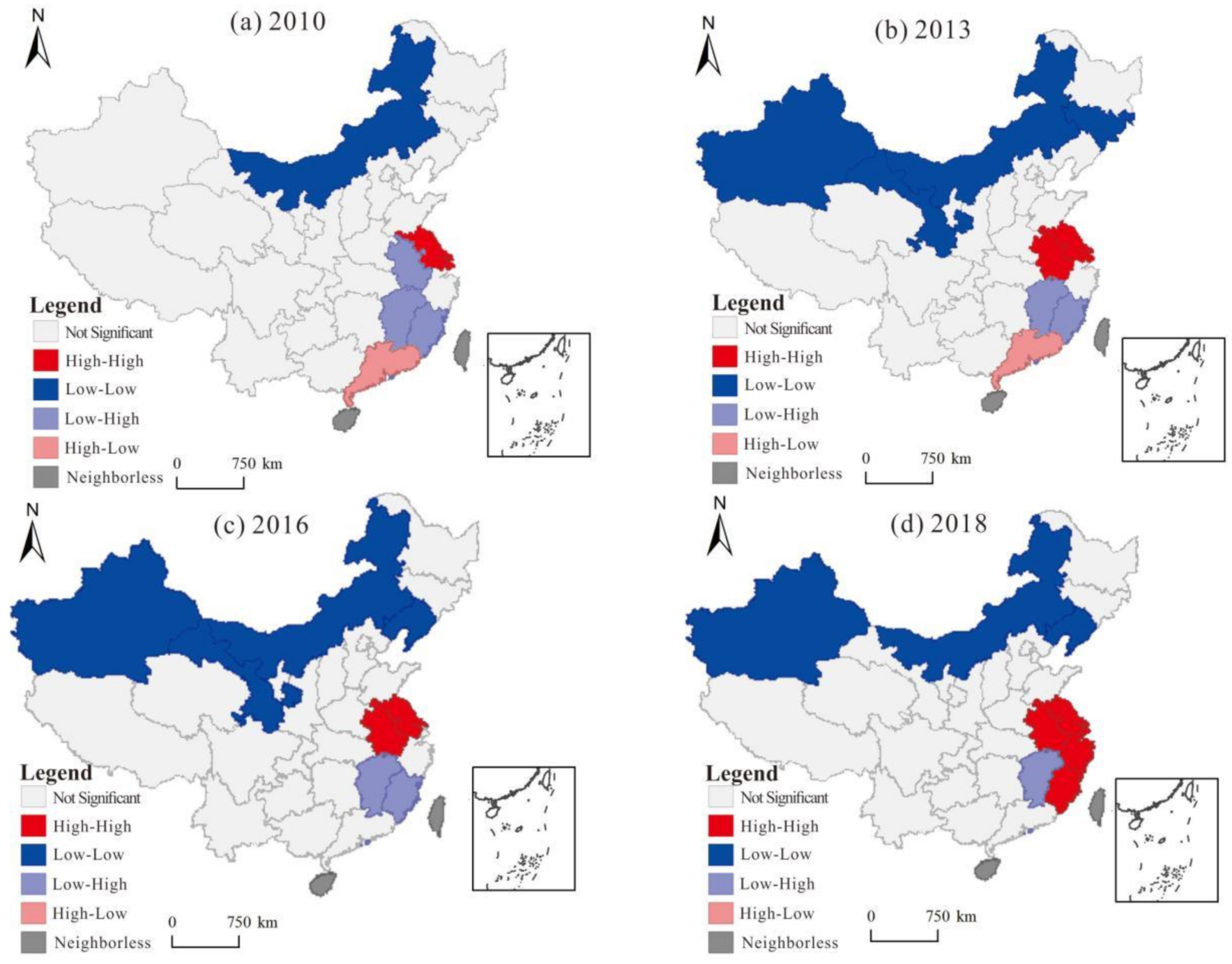Spatio-Temporal Evolution and Mechanism Analysis of China’s Regional Innovation Efficiency
Abstract
1. Introduction
2. Materials and Methods
2.1. Calculation of Innovation Efficiency
2.1.1. Bootstrapped DEA
2.1.2. Selection of Input and Output Indicators
2.1.3. Spatial Autocorrelation Analysis
2.2. Analysis of Influencing Factors of Innovation Efficiency
2.2.1. SDM Model
2.2.2. Selection of Influencing Factors
3. Results
3.1. The Temporal Characteristics of Innovation Efficiency
3.2. The Spatial Distribution Characteristics of Innovation Efficiency
3.3. Spatial Correlation Features
4. Discussion
4.1. Analysis of Influencing Factors of Innovation Efficiency
4.2. Analyses of the Mechanism of Innovation Efficiency
5. Conclusions
5.1. Conclusions
- The time-series changes in innovation efficiency showed a general trend from decreasing to increasing. At the regional level, the innovation efficiency for 2010–2012 showed a pattern of eastern region > central region > western region. From 2013 to 2018, the innovation efficiency of the western region greatly improved, and the arrangement pattern between regions shifted considerably.
- The spatial change in innovation efficiency was generally characterized as high in the east and low in the west. The innovation efficiency at the provincial level demonstrated an evolution process from decentralized to concentrated. The innovation efficiency of provinces in the eastern region was relatively stable, while that of provinces in the central and western regions increased significantly. Additionally, the east–middle–west evolution pattern gradually weakened.
- Using the global spatial autocorrelation, innovation efficiency was found to have spatial dependence. The value of Moran’s I shows a slowly rising trend, indicating that the spatial agglomeration of innovation efficiency has continued to increase. In terms of the local spatial autocorrelation, the extent of hot spots continued to expand during the study period, while cold spots slightly decreased.
- In terms of the effect mechanism, different factors had varying effects on innovation efficiency at different periods. The results showed that scientific research environment, entrepreneurial environment, labor quality, and market environment had significant effects on innovation efficiency, and their impact varied considerably for different years.
5.2. Recommendations
Author Contributions
Funding
Institutional Review Board Statement
Informed Consent Statement
Data Availability Statement
Conflicts of Interest
References
- Krugman, P. Development, Geography and Economic Theory; MIT Press: Cambridge, MA, USA, 1995. [Google Scholar]
- Ke, H.; Dai, S.; Yu, H. Spatial effect of innovation efficiency on ecological footprint: City-level empirical evidence from China. Environ. Technol. Innov. 2021, 22, 101536. [Google Scholar] [CrossRef]
- Lan, H.; Zhao, X. Spatial-Temporal Evolution and Innovation Environment Factors of Regional Innovation Efficiency in China. Econ. Geogr. 2020, 40, 97–107. (In Chinese) [Google Scholar]
- De Noni, I.; Orsi, L.; Belussi, F. The role of collaborative networks in supporting the innovation performances of lagging-behind European regions. Res. Policy 2018, 47, 1–13. [Google Scholar] [CrossRef]
- Luo, Q.; Miao, C.; Sun, L.; Meng, X.; Duan, M. Efficiency evaluation of green technology innovation of China’s strategic emerging industries: An empirical analysis based on Malmquist-data envelopment analysis index. J. Clean. Prod. 2019, 238, 117782. [Google Scholar] [CrossRef]
- Fan, F.; Lian, H.; Liu, X.; Wang, X. Can environmental regulation promote urban green innovation Efficiency? An empirical study based on Chinese cities. J. Clean. Prod. 2021, 287, 125060. [Google Scholar] [CrossRef]
- Min, S.; Kim, J.; Sawng, Y. The effect of innovation network size and public R&D investment on regional innovation efficiency. Technol. Forecast Soc. 2020, 155, 119998. [Google Scholar]
- Lin, B.; Luan, R. Are government subsidies effective in improving innovation efficiency? Based on the research of China’s wind power industry. Sci. Total Environ. 2020, 710, 136339. [Google Scholar] [CrossRef] [PubMed]
- Kalapouti, K.; Petridis, K.; Malesios, C.; Dey, P. Measuring efficiency of innovation using combined Data Envelopment Analysis and Structural Equation Modeling: Empirical study in EU regions. Ann. Oper. Res. 2020, 294, 297–320. [Google Scholar] [CrossRef]
- Omri, A.; Bel Hadj, T. Foreign investment and air pollution: Do good governance and technological innovation matter? Environ. Res. 2020, 185, 109469. [Google Scholar] [CrossRef] [PubMed]
- Bin, Q.; Zhao, X.; Hu, Z. Performance Evaluation of Technological Innovation Mode on the Equipment Manufacturing Industry of Shanxi Province. Procedia Eng. 2011, 15, 4908–4911. [Google Scholar] [CrossRef][Green Version]
- Jianmin, W.; Li, Y. Does factor endowment allocation improve technological innovation performance? An empirical study on the Yangtze River Delta region. Sci. Total Environ. 2020, 716, 137107. [Google Scholar] [CrossRef]
- Chen, M.; Sinha, A.; Hu, K.; Shah, M.I. Impact of technological innovation on energy efficiency in industry 4.0 era: Moderation of shadow economy in sustainable development. Technol. Forecast Soc. 2021, 164, 120521. [Google Scholar] [CrossRef]
- Zhao, P.; Zeng, L.; Lu, H.; Zhou, Y.; Hu, H.; Wei, X. Green economic efficiency and its influencing factors in China from 2008 to 2017: Based on the super-SBM model with undesirable outputs and spatial Dubin model. Sci. Total Environ. 2020, 741, 140026. [Google Scholar] [CrossRef]
- Liu, Y.; Dong, F. How technological innovation impacts urban green economy efficiency in emerging economies: A case study of 278 Chinese cities. Resour. Conserv. Recycl. 2021, 169, 105534. [Google Scholar] [CrossRef]
- Fried, H.O.; Lovell, C.A.K.; Schmidt, S.S.; Yaisawarng, S. Accounting for Environmental Effects and Statistical Noise in Data Envelopment Analysis. J. Prod. Anal. 2002, 17, 157–174. [Google Scholar] [CrossRef]
- Léopold, S.; Paul, W. Sensitivity Analysis of Efficiency Scores: How to Bootstrap in Nonparametric Frontier Models. Manag. Sci. 1998, 44, 49–61. [Google Scholar]
- Li, H.; Pang, S.; Cao, Y.; Gao, J. Research on the evaluation of comprehensive efficiency of technological innovation and eco-environment in China. J. Clean Prod. 2021, 283, 124603. [Google Scholar] [CrossRef]
- Griffith, D.A. Spatial Autocorrelation. In International Encyclopedia of Human Geography, 2nd ed.; Kobayashi, A., Ed.; Elsevier: Oxford, UK, 2020; pp. 355–366. [Google Scholar]
- Goodchild, M.F. Geographical data modeling. Comput. Geosci. 1992, 18, 401–408. [Google Scholar] [CrossRef]
- Yuan, J.; Beard, K.; Johnson, T.R. A quantitative assessment of spatial patterns of socio-demographic change in coastal Maine: One process or many? Appl. Geogr. 2021, 134, 102502. [Google Scholar] [CrossRef]
- Peng, W.; Yin, Y.; Kuang, C.; Wen, Z.; Kuang, J. Spatial spillover effect of green innovation on economic development quality in China: Evidence from a panel data of 270 prefecture-level and above cities. Sustain. Cities Soc. 2021, 69, 102863. [Google Scholar] [CrossRef]
- Elhorst, J.P. Dynamic spatial panels: Models, methods, and inferences. J. Geogr. Syst. 2012, 14, 5–28. [Google Scholar] [CrossRef]
- Wei, G.; Sun, P.; Jiang, S.; Shen, Y.; Liu, B.; Zhang, Z.; Ouyang, X. The Driving Influence of Multi-Dimensional Urbanization on PM2.5 Concentrations in Africa: New Evidence from Multi-Source Remote Sensing Data, 2000–2018. Int. J. Environ. Res. Public Health 2021, 18, 9389. [Google Scholar] [CrossRef]
- Pan, X.; Guo, S.; Li, M.; Song, J. The effect of technology infrastructure investment on technological innovation—A study based on spatial durbin model. Technovation 2021, 107, 102315. [Google Scholar] [CrossRef]
- Veiga, P.M.; Teixeira, S.J.; Figueiredo, R.; Fernandes, C.I. Entrepreneurship, innovation and competitiveness: A public institution love triangle. Socio-Econ. Plan. Sci. 2020, 72, 100863. [Google Scholar] [CrossRef]
- Moshirian, F.; Tian, X.; Zhang, B.; Zhang, W. Stock market liberalization and innovation. J. Financ. Econ. 2021, 139, 985–1014. [Google Scholar] [CrossRef]
- Novakova, L. The impact of technology development on the future of the labour market in the Slovak Republic. Technol. Soc. 2020, 62, 101256. [Google Scholar] [CrossRef]
- Zeng, W.; Li, L.; Huang, Y. Industrial collaborative agglomeration, marketization, and green innovation: Evidence from China’s provincial panel data. J. Clean. Prod. 2021, 279, 123598. [Google Scholar] [CrossRef]
- Lv, C.; Shao, C.; Lee, C. Green technology innovation and financial development: Do environmental regulation and innovation output matter? Energy Econ. 2021, 98, 105237. [Google Scholar] [CrossRef]
- Zhang, J.; Wu, Q.; Zhou, Z. A two-stage DEA model for resource allocation in industrial pollution treatment and its application in China. J. Clean. Prod. 2019, 228, 29–39. [Google Scholar] [CrossRef]
- Li, X.; Ma, D. Financial agglomeration, technological innovation, and green total factor energy efficiency. Alex. Eng. J. 2021, 60, 4085–4095. [Google Scholar] [CrossRef]
- Zhao, S.L.; Song, W.; Zhu, D.Y.; Peng, X.B.; Cai, W. Evaluating China’s regional collaboration innovation capability from the innovation actors perspective—An AHP and cluster analytical approach. Technol. Soc. 2013, 35, 182–190. [Google Scholar] [CrossRef]




| First-Level Index | Second-Level Index | Unit | |
|---|---|---|---|
| X1 | Infrastructure | Internet broadband access ports | 10,000 |
| X2 | Opening to the outside world | Total import and export as a proportion of GDP | USD 10,000 |
| X3 | Research environment | Science and technology expenditure proportion | % |
| X4 | Quality of the labor force | Amount of the population with a college degree and above in the regional population sample | % |
| X5 | Market environment | Per capita consumption expenditure | CNY |
| X6 | Innovation and entrepreneurship level | Full-time equivalent of R&D personnel in industrial enterprises above designated size | % |
| X7 | Financial environment | Proportion of financial expenditure | CNY 100 million |
| Mean | Std. | Min | Max | |
|---|---|---|---|---|
| Three-stage Efficiency | 0.4924 | 0.1887 | 0.1599 | 1 |
| Bias-corrected Efficiency | 0.4440 | 0.1760 | 0.1037 | 0.8904 |
| SDM-1 | SDM-2 | SDM-3 | |
|---|---|---|---|
| X1 | 0.2204 *** | 0.8540 *** | −0.4756 *** |
| X2 | 0.1218 *** | 0.2987 ** | −0.1161 ** |
| X3 | 0.3612 *** | 0.3176 *** | 0.3031 *** |
| X4 | 0.0807 *** | 1.2764 *** | 0.8276 *** |
| X5 | 0.4664 ** | 0.4357 *** | 0.2122 ** |
| X6 | 1.0134 ** | 0.7296 ** | 0.4233 *** |
| X7 | −0.1203 ** | 0.3256 ** | −0.0585 *** |
| W·X1 | −1.0819 ** | 0.4766 *** | 2.5018 ** |
| W·X2 | −1.2196 *** | −0.0704 *** | −0.6351 *** |
| W·X3 | 0.7404 *** | 2.6167 ** | 1.3520 ** |
| W·X4 | 1.0147 *** | −0.3044 *** | −1.0669 ** |
| W·X5 | 0.1003 ** | −2.3697 * | −0.0509 *** |
| W·X6 | 0.6418 ** | −0.6482 *** | −2.3142 * |
| W·X7 | 0.0803 ** | 0.4613 ** | −0.2571 ** |
| R-squared | 0.9309 (SDM) | 0.9373 (SDM) | 0.9562 (SDM) |
| 0.9267 (SLM) | 0.9359 (SLM) | 0.9531 (SLM) | |
| 0.9262 (SEM) | 0.9351 (SEM) | 0.9519 (SEM) | |
| log-likelihood | 39.0817 (SDM) | 43.3483 (SDM) | 46.5754 (SDM) |
| 39.0705 (SLM) | 43.3100 (SLM) | 46.5576 (SLM) | |
| 39.0641 (SEM) | 43.3071 (SEM) | 46.5567 (SEM) | |
| 0.252 | 0.240 | 0.232 |
Publisher’s Note: MDPI stays neutral with regard to jurisdictional claims in published maps and institutional affiliations. |
© 2021 by the authors. Licensee MDPI, Basel, Switzerland. This article is an open access article distributed under the terms and conditions of the Creative Commons Attribution (CC BY) license (https://creativecommons.org/licenses/by/4.0/).
Share and Cite
Xu, Z.; Zhu, X.; Wei, G.; Ouyang, X. Spatio-Temporal Evolution and Mechanism Analysis of China’s Regional Innovation Efficiency. Sustainability 2021, 13, 11089. https://doi.org/10.3390/su131911089
Xu Z, Zhu X, Wei G, Ouyang X. Spatio-Temporal Evolution and Mechanism Analysis of China’s Regional Innovation Efficiency. Sustainability. 2021; 13(19):11089. https://doi.org/10.3390/su131911089
Chicago/Turabian StyleXu, Zhen, Xiang Zhu, Guoen Wei, and Xiao Ouyang. 2021. "Spatio-Temporal Evolution and Mechanism Analysis of China’s Regional Innovation Efficiency" Sustainability 13, no. 19: 11089. https://doi.org/10.3390/su131911089
APA StyleXu, Z., Zhu, X., Wei, G., & Ouyang, X. (2021). Spatio-Temporal Evolution and Mechanism Analysis of China’s Regional Innovation Efficiency. Sustainability, 13(19), 11089. https://doi.org/10.3390/su131911089







